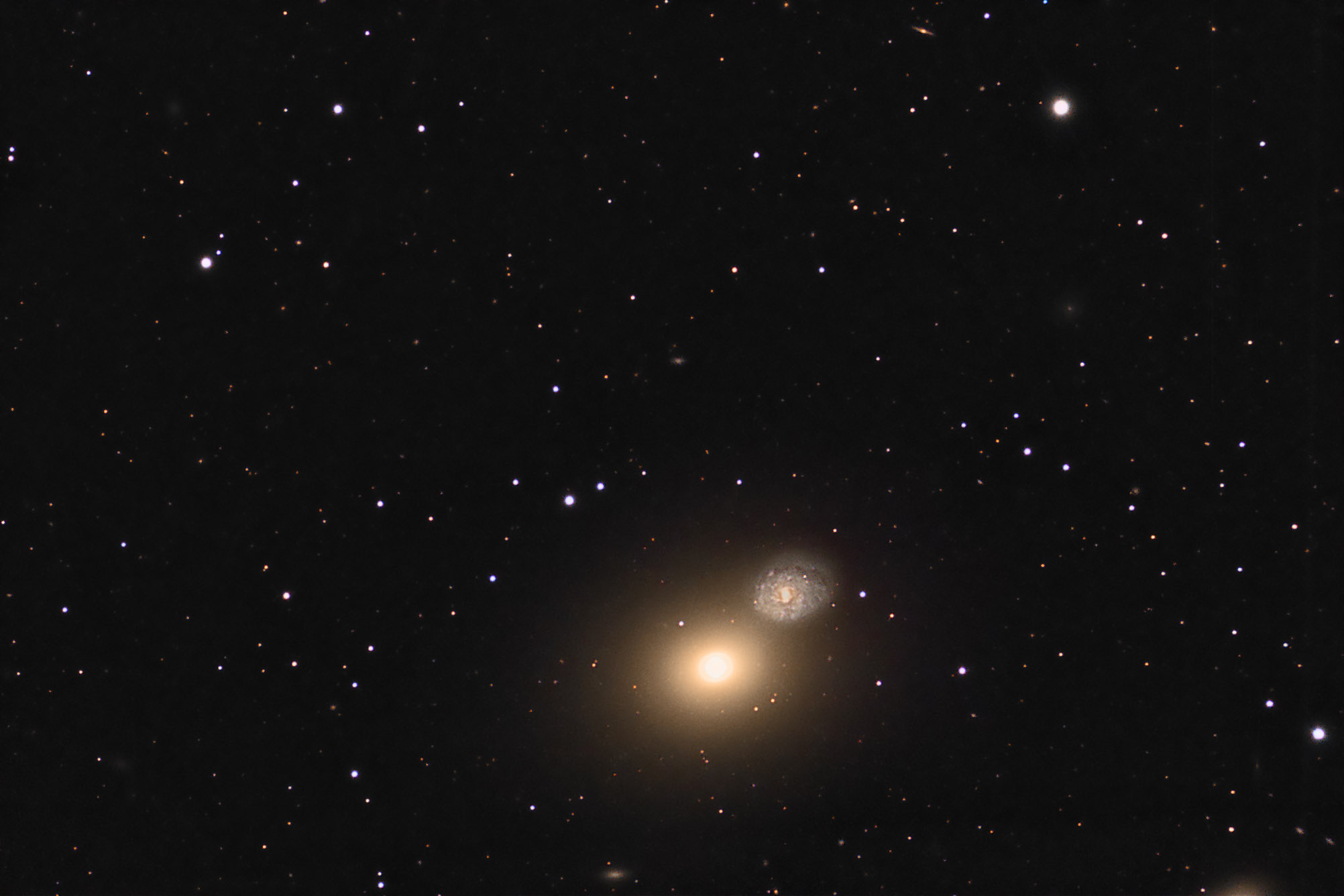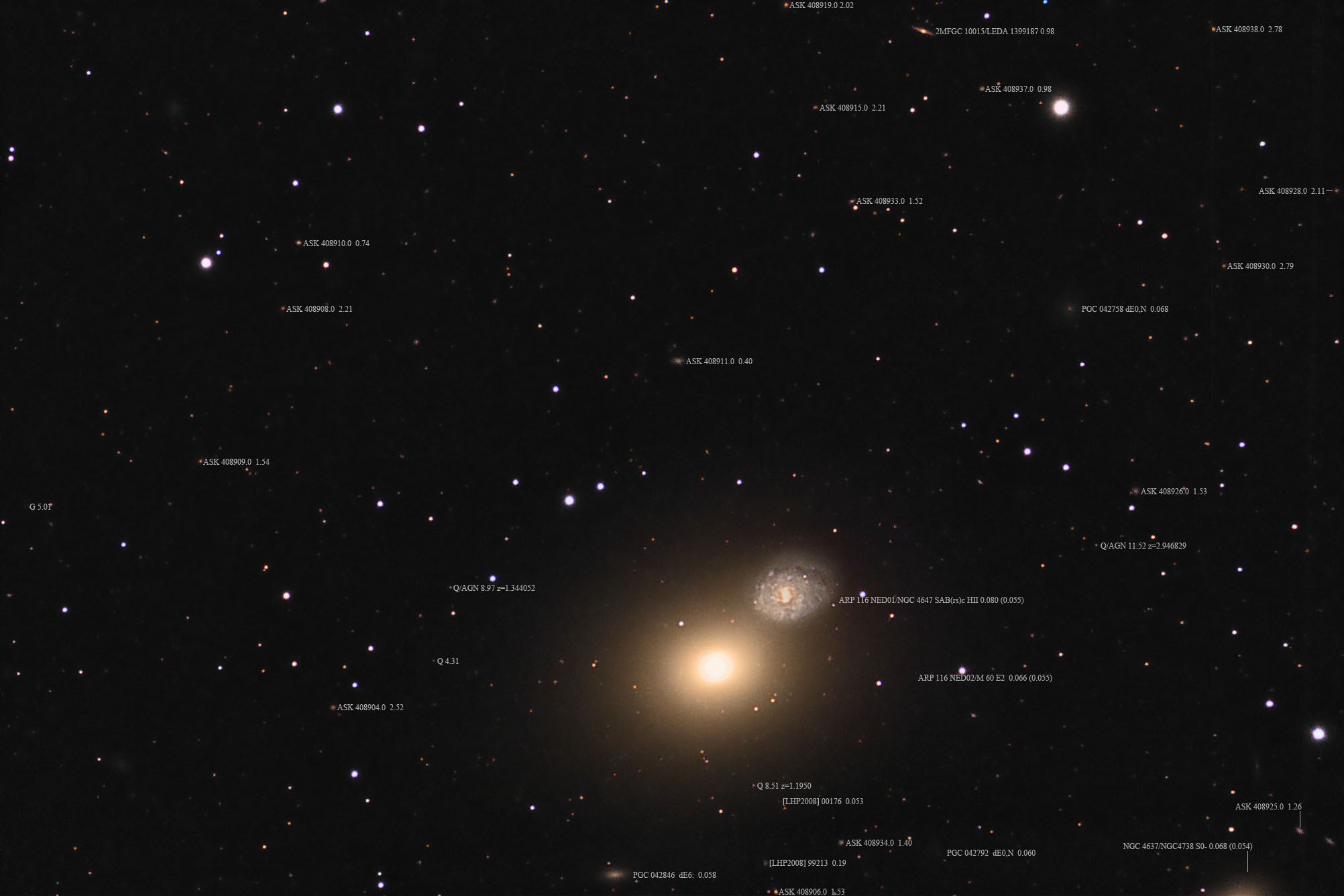| Description | Images |
Object name: ARP116Designation(s): ARP116, M060, NGC4637, NGC4647, NGC4649, Arp 116 belongs in Arp's class for elliptical and elliptical-like galaxies close to and perturbing spirals. In this case, it is M 60 that is the elliptical and NGC 4647 that is the spiral. It is slightly sloshed with the core off center toward M60 as if pulled there by its gravity. Is that really the case? Redshift puts NGC 4647 at about 80 million light-years and M 60 at 66. But non-redshift measurements have a median value of 55 million light-years for both. These are part of the Virgo cluster which is well known to for galaxies having a wide difference in redshift due to the strong gravity well created by so many galaxies in a small area. Redshift is not considered very reliable both because the cluster is rather close (averaging about 60 million light-years) and due to the wide variance of their widely varying speeds unrelated to distance. One study shows that the spiral must be behind M60 since none of its absorption features can be seen against M 60 as would be expected if it were in front. Since M60 has virtually no such features their lack against the spiral is expected even if it is in front of the spiral. How far they are apart is still unknown. With their difference in redshift, any passage by each other would be brief hardly giving time for any interaction to show. While it might distort a spiral arm slightly I doubt it could be the cause of the sloshing of NGC 4647's core. But this is only my surmise. It could be that since the side toward M 60 is bright due to being seen through M60 the fainter parts of NGC 4647 are hidden and it really isn't sloshed at all. Related Designation(s):1RXS J124340.6+113309, 2MASS J12434000+1133099, 2MASX J12425409+1126178, 2MASX J12433254+1134568, 2MASX J12434000+1133093, 2XMM J124339.9+113309, 2XMMp J124339.9+113309, ACSVCS 003, AGESVC2 22, AKARI J1243323+113452, ALFALFA 3-358, ARP 116, ARP 116 NED01, ARP 116 NED02, ARP116, CGCG 070-229 NED02, CGCG 071-006 NED02, CGCG 071-007, CGCG 071-015, CGCG 071-016, CGCG 1240.3+1143 NED02, CGCG 1240.4+1142, CGCG 1241.0+1152, CGCG 1241.1+1150, CXOKMZ J124339.9+113310, CXOU J124332.3+113457, CXOU J124339.9+113309, CXOU J124340.0+113311, EVCC 1099, EVCC 1101, FAUST 3409, FAUST V171, HDCE 0720 NED192, HDCE 0720 NED193, HIR J1243+1132, HOLM 448, HOLM 448A, HOLM 448B, IRAS 12410+1151, IRAS F12410+1151, KPG 353, KPG 353A, KPG 353B, LDCE 0904 NED236, LDCE 0904 NED237, LGG 289:[G93] 049, LGG 292:[G93] 026, M060, MCG +02-32-188, MCG +02-33-001, MCG +02-33-002, MESSIER 060, NGC 4637, NGC 4647, NGC 4649, NGC 4649:[KMZ2007] T14-001, NGC 4649:[LB2005] X01, NGC 4649:[LFS2013] 075, NGC 4649:[LFS2013] 253, NGC 4649:[RSI2004] 001, NGC4637, NGC4647, NGC4649, NSA 142078, NSA 162296, NVSS J124332+113458, NVSS J124340+113309, PGC 042744, PGC 042816, PGC 042831, RBS 1150, RGB J1243+115, RSCG 65:[WBJ2013] A, RSCG 65:[WBJ2013] C, RX J1243.6+1133, RX J1243.6+1133:[ZEH2003] 01 , RXC J1243.6+1133, SDSS J124254.09+112617.7, SDSS J124339.97+113309.7, UGC 07881, UGC 07896, UGC 07898, USGC U490 NED39, USGC U490 NED40, UZC J124332.0+113455, UZC J124339.7+113307, v2MCG 51:[DMP2012] 1, v2MCG 51:[DMP2012] 3, VCC 1945, VCC 1972, VCC 1978, VV 206, VV 206a, VV 206b, WBL 421-001, WBL 421-002, [BEC2010] HRS 244, [BEC2010] HRS 245, [FCJ2006] 003, [JBB2007] J124339.97+113309.6 , [M98j] 174 NED201, [M98j] 174 NED202, [MB2007] J190.9172+11.5526, [PJC2008] 003, [R83] 11deg060, [RG2008] J190.88542+11.58241 , [RG2008] J190.91656+11.55271 , [TH2002] 002, [TH2002] 014, [VPP2013] 19, |

